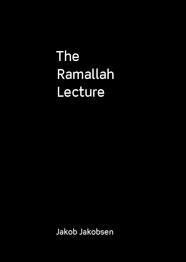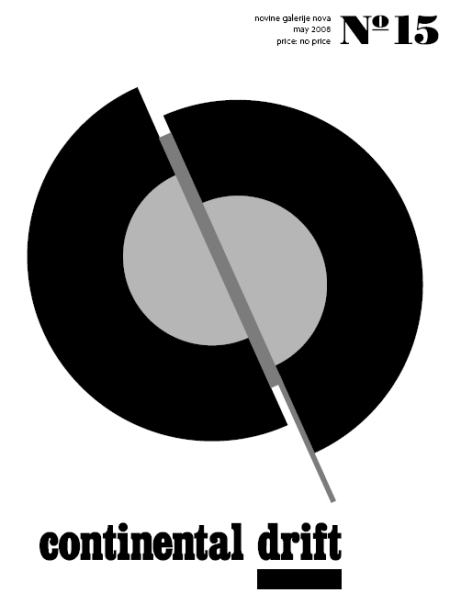Jakob Jakobsen: The Ramallah Lecture (2010)
Filed under book | Tags: · activism, art, palestine, politics, war

This book is based on a blog written by the visual artist and political activist Jakob Jakobsen during a six-week stay in Ramallah and the West Bank.
“In the summer of 2008 I visited Palestine. ArtSchool Palestine had invited me over for the purpose of meeting and working with local artists and other people in the occupied territories. As the theme of my visit was relatively open, my Palestinian host explained that my stay here could be understood as a type of artistic research. That suited me fine as I had worked with activist investigations and artistic research in The Copenhagen Free University for almost six years.
I’ve followed the situation in Palestine for many years and the Palestinian cause has persistently challenged my political sense of justice. Since September 11th 2001 the conflict has been spun more and more into the War against Terror and life for the Palestinians appears to have become even more troublesome. But what do you really know as an outsider and a media consumer in the West? In terms of the struggles over territory that go on in and around this small piece of land some call Palestine, what actually shapes the scenery that is produced in the public sphere? My stay in Palestine was an opportunity to get closer to the everyday conditions in the occupied territories, although I was constantly asking myself about my own role as an artist and a political person in this situation of conflict” (from the Introduction)
Publisher Nebula, Copenhagen; in association with ArtSchool Palestine, Ramallah, 2010
ISBN 978-87-993651-3-5
194 pages
Continental Drift Zagreb (2008)
Filed under newspaper | Tags: · activism, art, autonomy, capitalism, cartography, creative industries, economy, geopolitics, neoliberalism, politics, power, war

“It’s always useful to turn dreams into realities, because you get to measure the differences and even let yourselves be guided by the intrinsic gaps between the two. Continental Drift was the dream of a geopolitical analysis carried out by a diverse group (theorists, artists, activists) and mapped onto everyday social and political life as an expanding set of explanations and expressive potentials. The dream was made in USA, and even on Wall Street in New York City, but it was realized by a group of immigrants, returning exiles and general misfits, all marked by the basic heresy of left positions in an age of liberal capitalist empire. By transplanting this inquiry to Zagreb, Croatia – the home of the What, How & For Whom? collective – it seems we are bringing a new dream into focus. The desire is that of widening the intrepretative circle, crossing divides of language and historical experience, trying to build capacities of understanding and confrontation between the immigrants, exiles and misfits of the big continental blocs and especially their edges – the cracks that open up wherever anyone can no longer stand what is taken and imposed as the norm. Empire as we see it is always falling apart, for better and usually for worse, under the pressure of massive processes which we are unlikely to even see coming, let alone grasp or have the agency to change in any way. Yet as the urgency and also the absurdity of the present predicament begins to rise in intensity, at least all around there are people trying similar experiments.” (Brian Holmes)
Novine Galerije Nova, No 15, May 2008
Publishers: What, How and for Whom/WHW, Zagreb; AGM, Zagreb
Editors: Continental Drift Zagreb team (Ayreen Anastas, Rene Gabri, Brian Holmes, Claire Pentecost, What, How and for Whom/WHW, Ivet Ćurlin, Ana Dević, Nataša Ilić, Sabina Sabolović)
Design: Dejan Kršić
36 pages
Jordan Crandall (ed.): Under Fire 1 & 2. The Organization and Representation of Violence (2005)
Filed under book | Tags: · art, democracy, journalism, mass media, military, politics, war

Through a series of discussions about an array of issues–battle simulation techniques and news programming, democracy and violence, the privatization of the military, and militarized bodies–Jordan Crandall explores the organization and representation of contemporary armed conflict. Moderated by Crandall, Under Fire 1 is a compilation of a series of dialogues that occurred online from January 25 through April 19, 2004 between artists, political scientists, critics, activists, and journalists around the central theme.
Publisher Witte de With, Rotterdam, 2005
ISBN 90-73362-61-X
Length 96 pages

Under Fire 2 is the second collection edited by Jordan Crandall in an ongoing project that explores the organization and representation of armed conflict. Emerging from online dialogues among a group of artists, theorists, scientists, critics, activists, and journalists during three months of 2004 and reorganized thematically, the discussions in Under Fire 2 aim to offer new insights into symptomatic violence. The book covers issues such as the privatization of the military and the contributions of commercial and independent news media, as well as representations from artistic, literary, and popular entertainment sources, to our cultural perception of conflict. Rather than relying on discourses based on Western conceptions of modernity, the project is dedicated to opening up new historical perspectives, exploring the potential of Islamist points of view as sources of critical and political debate.
Publisher Witte de With, Rotterdam, 2005
ISBN 9073362652, 9789073362659
Length 112 pages
More info (author)
More info (project site)
More info (publisher)
More info (vol 1; google books)
More info (vol2; google books)

